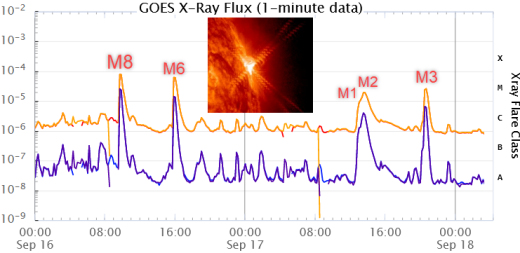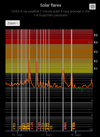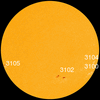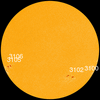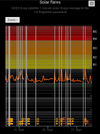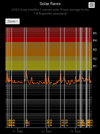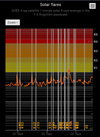SOLAR CYCLE 25 ACTIVITY REPORT SEP 18
Solar activity has been at moderate levels for the past 24 hours. The largest solar event of the period was a M2.6 event observed at 20:41 UTC on September 17 from AR3098. It generated minor R1 radio blackout over Pacífic Ocean.
AR3098 released several M flares earlier this week (the category of flare just under X) and has now released what was probably its last flare.
We have been talking about this phenomenon for a few months now. While an active region is on the visible face of the sun its activity remains low, however, as it moves westward its activity increases and starts to generate moderate flares until at the far edge strong M-class flares are produced that are possibly X-class:
Now in THIS forum post there was talk of the possibility of a Carrington event for this September 23rd according to a research that is based on science and Koran. Let's give it the benefit of the doubt. The candidate region to generate a severe X class flare (and we are talking about one equal to or greater than X45) would be the AR3089 region which will return in the next few days:
Will AR3089 have enough energy to generate a severe X-flare? We will have to wait and see.
There are currently 2 numbered sunspot regions on the disk: AR3100, and AR3102. Active Region 3103 is now a plage without sspots. AR3098 is gone.
AR3100 (S22W60) and AR3102 (S25W02) have both increased in size over the past 24 hours. The total number of sunspots has increased to 76. NOAA forecast is 75% chance for C flares, 20% chance for M flares and 5% chance for X flares.
▪︎Auroral Activity
The geomagnetic field has been at quiet levels for the past 24 hours. Solar wind speed reached a peak of 388 km/s at 20:22 UTC on sep 16
Current Conditions at 15:00 UTC on September 18
▪︎Geospace quiet
▪︎Geomagnetic conditions now KP=3
▪︎Solar wind speed record: 486.6 km/sec
▪︎density: 10.87 protons/cm3
▪︎Neutron Counts today: +4.1% Elevated
▪︎Sunspot number: 76 (SN 64 Sep 17)
▪︎Earth is inside a stream of solar wind flowing from a northern coronal hole.
▪︎New Coronal hole approaching.
SpaceWeatherlive..com
SpaceWeather.com
EarthSky.com
Solar activity has been at moderate levels for the past 24 hours. The largest solar event of the period was a M2.6 event observed at 20:41 UTC on September 17 from AR3098. It generated minor R1 radio blackout over Pacífic Ocean.
AR3098 released several M flares earlier this week (the category of flare just under X) and has now released what was probably its last flare.
We have been talking about this phenomenon for a few months now. While an active region is on the visible face of the sun its activity remains low, however, as it moves westward its activity increases and starts to generate moderate flares until at the far edge strong M-class flares are produced that are possibly X-class:
DODGING SOLAR STORMS: How long can Earth keep dodging solar storms? Departing sunspot AR3098 unleashed five M-class solar flares as it was going around the edge of the sun this weekend. One of them (M8 on Sept. 16th) was almost an X-flare:
Because AR3098 was not facing Earth, all of the flares were muted in their effect, and none produced an Earth-directed CME. Add them to the list of dozens of misses since August--all produced by departing sunspots.
The sun is shooting like an Imperial Storm Trooper. Don't get used to it, though. As Solar Cycle 25 unfolds, a stray hit is inevitable. SpaceWeather.com
Now in THIS forum post there was talk of the possibility of a Carrington event for this September 23rd according to a research that is based on science and Koran. Let's give it the benefit of the doubt. The candidate region to generate a severe X class flare (and we are talking about one equal to or greater than X45) would be the AR3089 region which will return in the next few days:
AR3089 nears return
The region we knew as AR3089 (when it was on our side of the sun) is about two days away from returning to the sun’s Earth-facing side. This region was very active when last seen directly from Earth. And it’s the region that sent a CME blast toward Europe’s Solar Orbiter, shortly before the spacecraft’s early September flyby of Venus (the spacecraft is okay). AR3089 also produced a large flare when it was just about over the sun’s limb – just as we couldn’t see it from Earth anymore – estimated by Solar Orbiter to be an X flare, the strongest category of flare.

This mage – created using helioseismology – is showing us dark patches from magnetic field concentrations (sunspots) on the sun’s far side at 12 UTC on September 17, 2022. We believe that this large patch of sun activity is the sunspot designated AR3089 when it was last seen on the sun’s Earth-facing side. Read more below. Image via SDO and Stanford U. EarthSky.com
Will AR3089 have enough energy to generate a severe X-flare? We will have to wait and see.
There are currently 2 numbered sunspot regions on the disk: AR3100, and AR3102. Active Region 3103 is now a plage without sspots. AR3098 is gone.
AR3100 (S22W60) and AR3102 (S25W02) have both increased in size over the past 24 hours. The total number of sunspots has increased to 76. NOAA forecast is 75% chance for C flares, 20% chance for M flares and 5% chance for X flares.
▪︎Auroral Activity
The geomagnetic field has been at quiet levels for the past 24 hours. Solar wind speed reached a peak of 388 km/s at 20:22 UTC on sep 16
Current Conditions at 15:00 UTC on September 18
▪︎Geospace quiet
▪︎Geomagnetic conditions now KP=3
▪︎Solar wind speed record: 486.6 km/sec
▪︎density: 10.87 protons/cm3
▪︎Neutron Counts today: +4.1% Elevated
▪︎Sunspot number: 76 (SN 64 Sep 17)
▪︎Earth is inside a stream of solar wind flowing from a northern coronal hole.
▪︎New Coronal hole approaching.
SpaceWeatherlive..com
SpaceWeather.com
EarthSky.com

